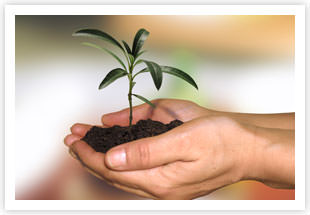|
Home Kids Center Steps to Go Green Green at Work Green at Home Recycling Events About Us Contact Us |
||
 |
|
|
|
|
|
Go Green at HomeThe opportunities and benefits of going green at home are endless. The impact you can have will last for many years. Please see "Steps to Go Green" for additional easy tips. 1. Buy Only What You NeedPlain and simple -
don’t over purchase. 2. Recycle, Recycle, Recycle!Earth 911 offers
recycling, reuse and proper disposal options for over 250 different
materials. Everything from aluminum cans and plastic bags to
construction materials. Don’t forget the last step in the recycling loop - Buy Recycled! In order for recycling to be sustainable, we need to purchase recycled-content materials! Look for and purchase post-consumer recycled content packaging and products whenever possible. 3. Change a Light, Change the WorldWhen your incandescent light bulbs stop working, replace them with the new, energy efficient compact fluorescent light bulbs (CFLs). According to the U.S. Environmental Protection Agency (EPA) CFLs use 2/3 less energy as a traditional incandescent light bulbs and last 10 times as long! Making this switch will save you money AND energy! Some incandescent light bulbs may contain lead solder and CFLs contain mercury, so remember to dispose of both properly at your local Hazardous Waste facility. To find out where to recycle, go to County of San Joaquin recycle page. Take the U.S. EPA’s ENERGY STAR pledge, to save energy and help reduce the risks of global climate change by replacing at least one light in my home with an ENERGY STAR qualified one. 4. Bag It Up the Green WayPlastic bags are getting the “thumbs down” in several communities around the country because of litter problems. When going to the store, consider bagging your own groceries in cloth, reusable bags. Many stores, such as IKEA, sell reusable bags and charge to provide plastic grocery bags. Save a plastic tree (and petroleum) - use a cloth bag! When walking your dog and cleaning up after then, use a biodegradable
bag rather than a plastic bag. 5. Green Your GadgetsDid you know the average cell phone is replaced every X years? Electronics become “outdated” so much more quickly than 10 or 20 years ago. To insure you are responsible with your gadgets, consider doing the following:
6. Make Every Drop CountEven though 70% of
the world is covered by water, less than 1% is fresh enough to drink or
use. With so little fresh water, we need to conserve all that we can. Compost food scraps instead of using your garbage disposal. You’ll save gallons of water every time and have a great soil amendment for your garden. Clean your driveway or sidewalk with a broom instead of hosing it down
with water. You’ll save at least 80 gallons of water every time. 7. Turn Up the SavingsA few degrees can make all the difference in your energy savings and your wallet. In the summer raise your thermostat two degrees. In the winter lower your thermostat two degrees. You probably won’t notice the difference at least until your utility bill arrives! Use a ceiling fan to cool off a room or house. It consumes as little
energy as a 60-watt bulb, which is about 98 percent less energy than
most central air conditioners. When replacing an appliance, be sure to look for one that is more energy efficient. Always look for the ENERGY STAR symbol and compare water and energy usage to ensure you get the best product and environmental savings to suit your needs. 8. Clear the AirCarpool, ride the bus, use public transportation or bike to work. Telecommute. Employee productivity will increase. Keep your tires inflated to the appropriate air pressure level. This will extend the life of your tires and give you better gas mileage. Drive the speed limit. Service your car on a regular basis per the manufacturer guidelines. In the market for a new car? Consider one of the new hybrid or fuel efficient vehicles. 9. Save A TreeSave paper, time
and postage, pay your bills online. When printing documents, print on both sides of paper. You can cut your paper consumption in almost half. Besides, when printing out a 200 page report, do you REALLY need 200 one-sided pages? Email documents and information instead of printing and mailing them. Save documents on your computer or on a disk instead of in a print copy in your filing cabinet. You’ll free up lots of space! 10. Home Sweet HomeClotheslines are
making a comeback - Dry your clothes on the line instead of in the
dryer. They will smell better and you will save money (and get some
exercise!) Make your own less toxic cleaning alternatives using baking soda, soap and vinegar. You will save money and your house won’t smell like a hospital! When repainting a room, be sure to look for paint that is low VOC (volatile organic compounds). Several manufacturers now offer VOC paints and they don’t leave that paint fume smell! Open the doors and windows to let the fresh air in! Indoor air quality is often times worse than the air outside. Open doors and windows daily to circulate fresh air in and germs and smells out. |

DID YOU KNOW?
|
||